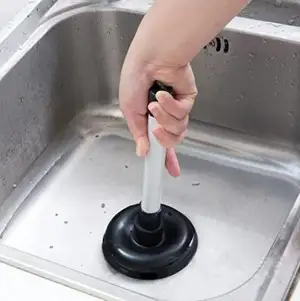Successful Plungers and Drain Cleaners Application: Key Tips
Successful Plungers and Drain Cleaners Application: Key Tips
Blog Article
We've stumbled upon this post relating to How to Unclog Your Sink with a Plunger listed below on the net and thought it made sense to discuss it with you on this site.

Introduction
Appropriate upkeep of home drains is important for avoiding blockages and making certain smooth water flow. One of the trick tools in every home owner's toolkit is the bettor, together with various drainpipe cleansers developed to tackle persistent clogs effectively. This post discovers just how to utilize plungers and drainpipe cleaners properly to keep your drains pipes moving freely.
Section 1: Understanding Plungers
Types of Plungers
There are several kinds of bettors available, each created for various kinds of drains pipes and blocks. The most typical kinds include cup plungers, flange plungers, and accordion bettors.
Exactly How Plungers Job
Plungers deal with the principle of producing stress and suction to displace blockages. When correctly applied over a drain, they produce a vacuum cleaner that can take out debris or break up obstructions.
Selecting the Right Plunger
Selecting the ideal plunger depends upon the type of drain and the nature of the clog. Mug plungers are excellent for sinks and tubs, while flange bettors are better matched for commodes due to their design.
Common Blunders with Plungers
Preventing these errors makes certain efficient plunging: inappropriate seal around the drainpipe, inadequate pressure, and unclear surrounding debris.
Area 2: Making Use Of Plungers Successfully
Preparation
Prior to diving, make sure the plunger covers the drain entirely and develops a tight seal. Clear any kind of visible debris around the drainpipe opening.
Method
Beginning with gentle plunging activities to build suction. Increase pressure progressively, utilizing a consistent rhythm. Repeat as essential until the drainpipe removes.
Repairing Tips
If plunging doesn't function, try adjusting the seal, using petroleum jelly for a better seal, or making use of a different kind of bettor.
Area 3: Recognizing Drain Cleansers
Kinds Of Drain Cleansers
Drain pipes cleaners can be chemical or chemical. Chemical cleansers use solid chemicals to liquify clogs, while chemical cleaners utilize natural enzymes to break down organic matter.
Exactly How Drain Cleansers Job
Chemical cleaners react with obstructions to dissolve them, while enzymatic cleansers break down organic materials like hair and oil without harming pipes.
Safety and security Considerations
Constantly put on gloves and eye defense when using chemical drain cleaners. Guarantee ample ventilation and adhere to producer instructions very carefully.
Eco-Friendly Alternatives
Take into consideration making use of vinegar and cooking soft drink or enzyme-based cleansers for green alternatives that are safer for pipelines and the atmosphere.
Section 4: Utilizing Drainpipe Cleaning Company Effectively
Application Methods
Pour chemical cleansers directly into the drain opening. Permit them to work for the recommended time before purging with hot water. Enzymatic cleansers ought to sit overnight.
Precautions
Avoid blending various kinds of cleansers, as this can generate poisonous fumes. Never ever use chemical cleaners combined with a bettor, as splashing can take place.
Handling Stubborn Obstructions
For relentless clogs, think about using a plumbing snake or calling an expert plumbing technician to stop damage to pipelines.
Verdict
Finally, understanding how to utilize bettors and drain cleansers effectively is necessary for maintaining healthy plumbing systems. By selecting the right tools and methods, property owners can tackle minor obstructions and stop significant plumbing issues down the line.
How To Properly Use A Plumbing Snake To Clear Drains
When any drain clogs in our home arise, we tend to gravitate toward the plunger and little else. In cases where the plunger and its vacuum-created pressure are not able to clear clogs, many immediately move to harmful chemicals or simply call their plumber to fix the issue.
we’re happy to help with all drain cleaning needs and concerns. This includes informing you on a few other home remedies you may have at your disposal for minor to moderate clogs, one of which is the use of a plumbing snake. Many people have never used one of these before – let’s go over the steps to take when your drain clogs and you have a plumbing snake available.
Attempt Plunger Use
The first step here, as we noted above, should indeed be to grab your plunger when you notice a drain clog and attempt to resolve it this way. If you’re unsure how to use a particular type of plunger, our plumbers can answer any questions you have. If this doesn’t do the trick, however, you move on to the snake.
Locate And Prepare Snake
A plumbing snake is a metal or plastic device that’s generally about a quarter of an inch thick. It’s design with significant extensions, meant to reach down into your clogged drain and push the clog out. Snakes also contain drain augers that will latch onto and push stubborn blockages.
If your plunger doesn’t clear a clog, locate your snake and bring it to the drain in question. We also recommend keeping a bucket nearby to collect the clog once you pull it out, plus we’d advise wearing goggles and possibly protective gloves.
Feed Snake
Once you’re ready to go, feed the snake slowly down the drain, using the crank device it comes with to keep it moving until it finds the clog. Once this happens, much of the clog will be latched onto the coil so you can pull it out, while the rest will simply break up and flow downward.
Detach Debris
Remove the snake slowly from the drain, and once you’ve done so, pick off any debris that’s stuck to the coil. This is another area where wearing gloves is a must.
Flush Drain
Finally, take a few minutes to ensure the snake has done its job correctly. If you’ve been using it on a toilet, flush the toilet a couple times and make sure everything flows well. If you’ve used it on a different drain, flush it with some room temperature water.
https://www.mybuddytheplumber.com/blog/how-to-properly-use-a-plumbing-snake-to-clear-drains/

Application Methods
Pour chemical cleansers directly into the drain opening. Permit them to work for the recommended time before purging with hot water. Enzymatic cleansers ought to sit overnight.
Precautions
Avoid blending various kinds of cleansers, as this can generate poisonous fumes. Never ever use chemical cleaners combined with a bettor, as splashing can take place.
Handling Stubborn Obstructions
For relentless clogs, think about using a plumbing snake or calling an expert plumbing technician to stop damage to pipelines.
Verdict
Finally, understanding how to utilize bettors and drain cleansers effectively is necessary for maintaining healthy plumbing systems. By selecting the right tools and methods, property owners can tackle minor obstructions and stop significant plumbing issues down the line.
How To Properly Use A Plumbing Snake To Clear Drains
When any drain clogs in our home arise, we tend to gravitate toward the plunger and little else. In cases where the plunger and its vacuum-created pressure are not able to clear clogs, many immediately move to harmful chemicals or simply call their plumber to fix the issue.
we’re happy to help with all drain cleaning needs and concerns. This includes informing you on a few other home remedies you may have at your disposal for minor to moderate clogs, one of which is the use of a plumbing snake. Many people have never used one of these before – let’s go over the steps to take when your drain clogs and you have a plumbing snake available.
Attempt Plunger Use
The first step here, as we noted above, should indeed be to grab your plunger when you notice a drain clog and attempt to resolve it this way. If you’re unsure how to use a particular type of plunger, our plumbers can answer any questions you have. If this doesn’t do the trick, however, you move on to the snake.
Locate And Prepare Snake
A plumbing snake is a metal or plastic device that’s generally about a quarter of an inch thick. It’s design with significant extensions, meant to reach down into your clogged drain and push the clog out. Snakes also contain drain augers that will latch onto and push stubborn blockages.
If your plunger doesn’t clear a clog, locate your snake and bring it to the drain in question. We also recommend keeping a bucket nearby to collect the clog once you pull it out, plus we’d advise wearing goggles and possibly protective gloves.
Feed Snake
Once you’re ready to go, feed the snake slowly down the drain, using the crank device it comes with to keep it moving until it finds the clog. Once this happens, much of the clog will be latched onto the coil so you can pull it out, while the rest will simply break up and flow downward.
Detach Debris
Remove the snake slowly from the drain, and once you’ve done so, pick off any debris that’s stuck to the coil. This is another area where wearing gloves is a must.
Flush Drain
Finally, take a few minutes to ensure the snake has done its job correctly. If you’ve been using it on a toilet, flush the toilet a couple times and make sure everything flows well. If you’ve used it on a different drain, flush it with some room temperature water.
https://www.mybuddytheplumber.com/blog/how-to-properly-use-a-plumbing-snake-to-clear-drains/

Do you enjoy reading up on A Guide to Plungers (and How to Use Them)? Place a remark down below. We would be glad to see your responses about this blog posting. We hope to see you back again in the near future. If you please pause to promote this page if you appreciated it. Thanks a lot for your time spent reading it.
Call Today Report this page